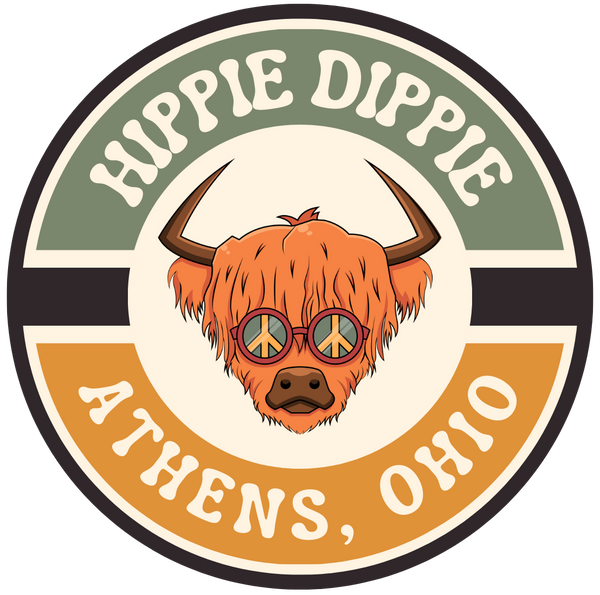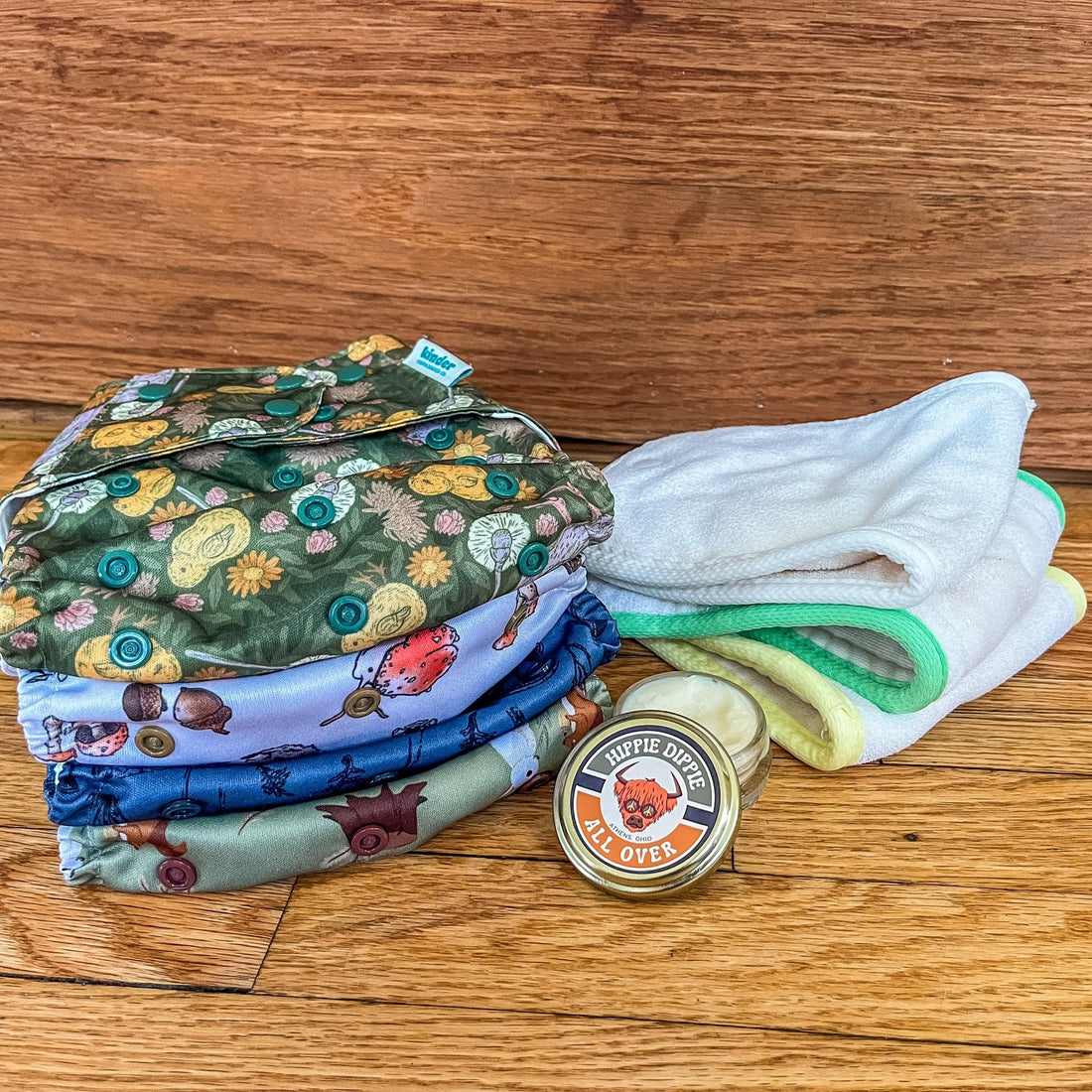Have you thought about cloth diapering and want to learn more? There is so much information out there it can be really overwhelming and seem like a huge undertaking. I promise, it is easier that it looks and easier than we thought it would be! We love it and would never go back to disposables.
I have compiled a condensed form of everything you need to know to get started and our favorite brands to help! Scroll to the bottom for my general opinions on cloth diapering :)

Types of Cloth Diapers:
Pocket: easy to use, the most popular style (it's what we use!)
- an absorbent insert is stuffed inside of a waterproof shell and most have a jersey lining to help baby stay dry and prevent rashes
- these are the most customizable, you can adjust the absorbency for different babies or times of the day or as the baby ages
- you can also pick and choose which brands you like for shells/inserts and mix and match
- cons: takes a smidge longer to prep since you have to stuff the inserts into the shells and then unstuff to wash
- these are single piece cloth diapers (absorbency + waterproofing)
- we don't use this kind, but they are probably good for newborns
- cons: take longer to wash/dry and aren’t as customizable for absorbency as the baby ages
- instead of stuffing the insert into a shell, these clip into the shell so that the absorbency sits right against the baby
- cons: not as common, more expensive, and the absorbency/moisture is right against baby
- this is a larger piece of cloth that either buttons or is clipped into place, usually still covered with a waterproof shell
- can really use any absorbent fabric to make the diaper, or purchase precut absorbency or ones with snaps
- good if you need the all around absorbency for really heavy wetters or bedtime
- cons: a little more work/steps each time you change a diaper (basically have to put on 2 diapers), absorbency sits right against baby


Cloth Diaper Brands:
So brand wise, it’s really up to you! There are SO MANY it can be overwhelming. Here is some condensed information
Alva Baby and other cheap amazon brands - not terrible- these tend to run small and not fit as long or hold as much absorbency
- can be a great option for skinny babies or just dipping your toes into the cloth diaper world
- you would likely need to purchase different absorbency inserts because they aren't the best
- these are middle of spectrum on price, usually fit from 8-25lbs
- we started with these brands - they run a little small for chunkier babies though
- their absorbency isn't the best, so I would suggest buying different ones or doubling up if you use these (they claim they're bamboo but function like microfiber - see more below)
- we use 100% kinder products now, they are a small company out of the USA, give back to the community, and have tons of educational videos online (TikTok)
- their prices are fairly in the middle and they fit from 7-60lbs .... all the way through potty training
- their absorbency is amazing and they have several different options and suggestions on layering
- They’re all similar in the high price range - people act like collectors with the prints so even buying used is expensive
- some have XL sizes though which can be great for chunkier babies/toddlers or those who potty train later
- I have heard their absorbencies (especially TT) are good


Inserts/Absorbency:
The type of fabric you use is extremely important for the functionality of the cloth diapers.
Microfiber- the word around the internet (and personal experience) is that these are the worst
- poor absorbency and prone to pressure leaks
- great option - very absorbent
- can get pressure leaks as babies move around
- great option - most absorbent type
- can get pressure leaks as well
- best option - very absorbent and no pressure leaks
- be careful on amazon - many brands claim they are bamboo, but they are just bamboo on the outside and filled with microfiber (aka they don't work well)
Most cloth diaper brands also sell absorbency inserts. We love Kinder. They have several options of different thicknesses that are either all bamboo or bamboo + cotton. Krystal, the owner, has videos on how to layer them and tips for light and heavy wetters.
Some people use “prefold” or “trifold” bamboo or cotton. Basically it's a square of fabric that you fold and then insert into the diaper shell to use as the absorbency. This can sometimes be a cheaper option or a good option for heavy wetters at night.
PS - Inserts need prepping!
You have to wash/dry new inserts at least 3x before using. This helps them fluff up and become absorbent. They will get more absorbent over time/with use as well…. It's just how natural fibers work 🤷♀️

How many do you need?
The amount you need will depend on your washing routine. If you wash more often, you won't need as many diapers. If you wash less often, you will need more. I saw a statistic that said most people had around 20 diapers and washed every other day.
We originally started with 12 diapers, but we had to do laundry at the 36 hour mark to make sure we had clean ones ready.... so we decided to bulk it up. We now have ~40 diapers and wash every 4-5 days. Basically, when our big wet bag gets full, we know it's time to wash them. This is much more manageable for us and takes the pressure off of us (because we suck at remembering to do laundry anyway).

Diaper Creams:
You aren’t supposed to use any petroleum-based diaper creams because they can affect the absorbency of the diapers. This takes out most commercial diaper creams including Aquaphor, Desitin, Vit A&D. Zinc is also not the best as a diaper for cloth diapers because it can cause staining.
Our favorite diaper cream is our All Over Tallow Balm. None of the ingredients affects the absorbency, there are fat soluble vitamins (A, D, E, K) naturally in the tallow, antibacterial properties in the coconut oil, is extremely hydrating for dry rashes, but also has some barrier protection like a petroleum based product would... but naturally.
We have also used our Sun Over Zinc Tallow Balm when fighting any yeast like rashes and it worked amazing. Think of it as a cloth diaper safe Desitin.
We also have our Face Over Tallow Balm and our Sunny Fave Over Tallow Balm incase your baby has a coconut oil allergy.
PS - A common misconception about cloth diapers is that babies will get rashes, however it is quite the opposite. When properly taken care of, the risk of rash is actually decreased because you are controlled what touches baby's bottom. Many families start using cloth diapers because they can't stop getting rashes with disposables.


Laundry:
Pee diapers are easy. You can just throw in the wet bag and then into the wash … you don’t have to rinse it out or anything.
Poopy diapers varies by age of the baby. Breastmilk only poop is water soluble so you can just throw these into the wash without rinsing (some people choose to rinse anyway)
Once they start eating foods, their poop changes and you need to rinse it off before washing. We have done it a few ways: rinse in a sink, rinse in toilet water, and using a spray bidet that you attach to the toilet. The sprayer is BY FAR the quickest and “cleanest” option. Also, pro-tip, spend the money and get a spray bucket that sits on the toilet, they’re lifesavers and make it 100x easier…. You just clip the diaper to it and then spray the poop into the toilet without making a mess.
They also make paper towel-like liners that are placed in the diaper and are disposable to catch solid poop. Then, you can just lift out the solids and throw it away. We tried them but we didn’t like them. It is easier and cleaner for us to just spray.
Storage: Store dirty diapers in a wet bag. They make large hanging wet bags, and that is what we use. We hang it on a towel rack in our bathroom. You should wash them within 5 days. We usually wash every 4. If you go too long, you run into the risk of getting mold or bugs on your diapers - we have never had this issue.
Detergent/Washing: Only certain detergents are "strong enough" to clean diapers - there’s a million lists online if you look up cloth diaper detergents. We chose to go with Biokleen laundry powder because we didn’t want some of the ingredients that are in more mainstream detergents. A lot of people use tide free & clear. Many people also recommend adding Borax, especially if you have hard water (Athens does) to prevent mineral build-up on them, which can negatively affect absorbency.
Click here for the master list of detergents and if they are safe for cloth diapers.
Make sure you take the diapers apart (separate insert from diaper) before washing. Most people do two wash cycles. We run a quick wash on cold first (we also set it to heavy soil) to rinse them and prevent stains. Then, we run a normal load (usually on super wash with heavy soil) with the detergent and borax
Then you can hang dry or dry in the dryer. Be careful with high heat, it is safe for the insert but can ruin the waterproofing of diaper shells and wet bags. We hang dry the diapers and wet bags and machine dry the liners on high heat.

My Opinions
A lot of people are worried about the time commitment.... We calculated and it only takes us about 15 extra minutes a week to cloth diaper compared to disposables. Changes themselves don't take any extra time, we spray the soiled diapers at the end of each day, and do laundry about every 4 days. It is a lot less work than I originally anticipated.
I have also heard people really worry about touching poop. Since switching to cloth from disposables, we have not had a single blow out. The way the elastics work really prevent any poop blowouts. I will say, sometimes pee leaks if you don't change the diaper often enough or when you are learning how to fit the diaper properly, but that shouldn't happen if you change regularly and once you get the hang of the snaps.
Others have claimed cloth diapers smell. Ours smells just like normal laundry. If you clean them properly, there should be no scent. If you aren't washing them properly, you can develop an odor (some people call this barnhouse). However, we recently had to use disposables for a bad infection our daughter had, and they smelled TERRIBLE compared to our cloth diapers. We were so happy to switch back after her infection cleared up.
We LOVE cloth diapering. They are more rigid for squirmy babies, can be used as swim diapers, aren't wasteful, and we know exactly what ingredients are touching our baby's bum.
If you have any questions or want to chat cloth diapers - shoot us a message!

